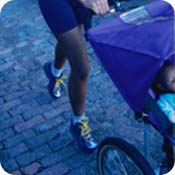 A fitness trend is sweeping the nation that involves balancing oneself on an oversized ball while performing functional resistance movements. The ball is referred to as a "physio" or "Swiss" ball and has grabbed the attention of numerous performance enhancement specialists. Traditional resistance training involves working a single joint in a single plane of motion, i.e. bicep curls. This type of training falls short in preparing an athlete for dynamic movements in sport or in day-to-day activities. Integrated training on the physioball facilitates multi-planar neuromuscular control that is more specific to athletic activities. A tremendous amount of stress is placed on the human body during everyday functional activities, so stable joints and muscle control are very important. A perfect example of this is carrying a box down a flight of stairs. The lumbar spine must stabilize the simultaneous contraction of the lower body (descending stairs) and the biceps and deltoids (carrying the box). In addition to stabilization, the entire spine must be balanced while stepping down one step at a time. Training on the physioball is excellent for strengthening the core muscule areas (abdominal, back, trunk). In addition to strengthening, physioball workouts teach and improve posture, balance, coordination, and flexibility. We need a strong core because it stabilizes our spine as we move. Attention to these areas can prevent low back pain as well as improve our dynamic balance. The exercises listed below are good beginner physioball techniques. Always maintain a slight arch in your lower back when performing these exercises. Regular breathing is also integral; don't hold your breath. Always consult with a physician before beginning any fitness program. Good luck.
A fitness trend is sweeping the nation that involves balancing oneself on an oversized ball while performing functional resistance movements. The ball is referred to as a "physio" or "Swiss" ball and has grabbed the attention of numerous performance enhancement specialists. Traditional resistance training involves working a single joint in a single plane of motion, i.e. bicep curls. This type of training falls short in preparing an athlete for dynamic movements in sport or in day-to-day activities. Integrated training on the physioball facilitates multi-planar neuromuscular control that is more specific to athletic activities. A tremendous amount of stress is placed on the human body during everyday functional activities, so stable joints and muscle control are very important. A perfect example of this is carrying a box down a flight of stairs. The lumbar spine must stabilize the simultaneous contraction of the lower body (descending stairs) and the biceps and deltoids (carrying the box). In addition to stabilization, the entire spine must be balanced while stepping down one step at a time. Training on the physioball is excellent for strengthening the core muscule areas (abdominal, back, trunk). In addition to strengthening, physioball workouts teach and improve posture, balance, coordination, and flexibility. We need a strong core because it stabilizes our spine as we move. Attention to these areas can prevent low back pain as well as improve our dynamic balance. The exercises listed below are good beginner physioball techniques. Always maintain a slight arch in your lower back when performing these exercises. Regular breathing is also integral; don't hold your breath. Always consult with a physician before beginning any fitness program. Good luck.
|
Put Some Bounce In Your Workout
Exercise With A Physioball
Page 1 of 1






Member Comments